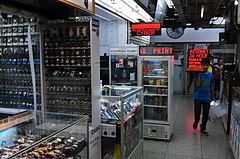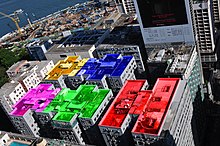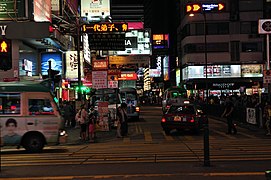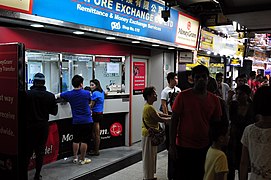Chungking Mansions
| Chungking Mansions 重慶 大廈 |
||
|---|---|---|
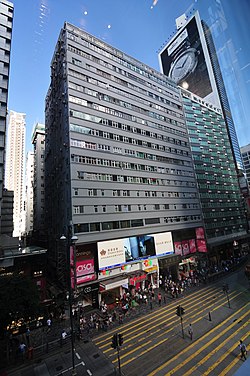 Chungking Mansion - main facade east elevation, Nathan Road 2013 |
||
| Data | ||
| place | 36-44 Nathan Road, Tsim Sha Tsui Hong Kong , China |
|
| Construction year | 1962 | |
| height | 55 m | |
| Floor space | 5000 m² | |
| Coordinates | 22 ° 17 '47 " N , 114 ° 10' 22.1" E | |
|
|
||
(2008-2018)

Chungking Mansions ( Chinese 重慶 大廈 / 重庆 大厦 , Pinyin Chóngqìng Dàshà , Jyutping Cung 4 hung 3 Daai 6 haa 6 ) is a building on the southern tip of Kowloon at the beginning of the north-south main artery Nathan Road in the Tsim Sha Tsui district of Hong Kong . It is known for the cultural diversity of residents and visitors as well as for the inexpensive accommodation options. The building is named after the "Chongqing Market" ( 重慶 市場 / 重庆 市场 , Chóngqìng Shìchǎng , Jyutping Cung 4 hung 3 Si 5 coeng 4 ), a smaller single-storey building that was located at this location until the 1950s. Its name in turn refers to the Chinese city of Chongqing - spelled "Chungking" according to the outdated transcription of the Chinese Post Office . Sometimes the atmosphere in the building is compared to that of the Kowloon Walled City , which was demolished in 1993 , and is described as Hong Kong's unofficial African district due to the many African small traders and business people.
Buildings and use
The mixed-use building consists of five blocks from A to E, each with 17 floors, with a total of 770 apartments, of which the shopping arcades extend over the lowest two floors and the basement. These shopping malls consist of various small shops and exchange offices . The upper floors of the five blocks are each served by two elevators and are not connected to each other. One of the two elevators each serve floors with even numbers or odd numbers. In addition to apartments, there are simple restaurants , such as African bistros , Nepalese restaurants, small Indian , Pakistani family restaurants for curry dishes , Southeast Asian cuisine as well as hostels and hotels in the lowest price category. The small shops often sell cell phones and related services and accessories, such as SIM and phone cards , or the like. In addition, there are also many shops for clothing - for example sari shops, special snacks and kiosks as well as various goods from the gray market in particular for retail and export trade to Southeast Asia and Africa.
The various shopping malls of the Chungking Mansion each have their own separate entrance in the building. They are structurally separated from each other and are only connected internally via escape routes. All shopping malls have their main entrance on the main facade of the building on Nathan Road.
- Cke
The shopping arcade Cke ( 重慶 站 商場 / 重庆 站 商场 , English Chungking Express ) can, for example, also be entered via a separate entrance on the side street of Nathan Road. This is located on part of the second and third floors of the Chungking Mansion, but apart from escape doors, there is no regular passage to the rest of the building. Compared to the shopping arcade on the ground floor of the Chungking Mansion, the design is visually appealing and kept clean, but also consists of narrow aisles and small shops that are rather untypical for a Hong Kong shopping center in this prominent location.
- WK Square
Another shopping arcade is WK Square ( WK 廣場 / WK 广场 ), formerly Wood House ( 活 方 商場 / 活 方 商场 , November 2009-2013), which has been open since 2014 , in the basement of the building, which has another separate entrance on the main street Nathan Road can be entered. In Cke and WK Square, bargaining for prices is rather unusual - unlike in the rest of the building - you can also buy high-quality goods there, which you shouldn't expect in the rest of the building.
geography
The Chungking Mansions skyscraper is located in the busy Yau Tsim Mong District at the southern end of the Kowloon Peninsula at the intersection of Nathan Road and Peking Road. It is in the direct vicinity of Tsim Sha Tsui-Ost ( English East Tsim Sha Tsui , 尖沙咀 東 / 尖沙咀 东 , mostly short 尖 東 / 尖 东 , English TST-East ), near the intersection of the two main roads Salisbury Road and Nathan Road.
Location and surroundings
The building is in close proximity to the MTR stations Tsim Sha Tsui and East Tsim Sha Tsui, surrounded by higher-priced hotels and shopping centers. The Kowloon Mosque and Islamic Center , Kowloon Park and the Tsim Sha Tsui Public Pier by Star Ferry are within walking distance, and the “ ISQUARE ” high-rise with shopping centers is directly opposite. Also nearby is the “ Mirador Mansions ” high-rise , which is reminiscent of the Chungking Mansions in terms of residents and the condition of the building, but is smaller and less known. The Chungking Mansions is somewhat reminiscent of the Kowloon Walled City , which was demolished in 1997 and was much larger. Around the corner on Salisbury Road, right on the shore to the sea, parallel to Victoria Harbor , is the Tsim Sha Tsui Clock Tower , the Peninsula Hotel and the Hong Kong Cultural Center Complex , an ensemble of various museums and cultural institutions such as Hong Kong Cultural Center , the Hong Kong Museum of Art , the Hong Kong Space Museum , the Salisbury Garden , the Avenue of Stars of Hong Kong, etc.
history
The previous single-storey building Chungking Mansion was called " Chongqing Market " ( 重慶 市場 / 重庆 市场 ). At the time of Japanese occupation of Hong Kong (1941-1945) was called the building a short time " Zhongxing Market " A ( 中興市場 / 中興市场 ), after the Japanese pronunciation "Chuko-Market" A . Chungking Mansions construction began in 1959 and was completed on November 11, 1962 as an upscale residential and commercial building and was one of the tallest buildings in the borough. Hence the name Mansions, which means something like mansion. The residents and shopkeepers of Chungking Mansions were mostly of Chinese and partly Indian origin. However, the confusing architecture and simple construction method led to the rapid decline in the value of the residential units, which were owned by several hundred owners. American soldiers ( GIs ) who were in Hong Kong during the Vietnam War (1955–1975) visited prostitutes in the Chungking Mansions in the late 1960s .
- Chungking Mansions - Exterior - Main Entrance
The owners increasingly left the building and many apartments were converted into hostels with small rooms. In the late 1970s, Chungking Mansions was a popular backpacker destination and was recommended as such by Lonely Planet travel guides. The large number of residents and visitors put a strain on the building's infrastructure, which was not designed for the many guest rooms. There were frequent fires in the building. In 1966 and 1971 there were two major fires in the house, in 1971 14 people were injured. There were 29 fire reports between 1985 and 1988. This remained without major consequences until in February 1988 a Danish tourist was killed in a fire when he tried to escape from the window. In July 1993 an explosion and a fire occurred in the connection room of the high-rise building for electricity due to an overload. The electricity and water supplies went out for ten days and nights. After the Chungking Mansions was already in disrepute among the Hong Kong population, the demands to abolish the grievances increased. The licensing regulations for inns were tightened and several dozen inns were closed. The police carried out raids and arrested illegal migrants. The owners decided to provide funds for the renovation and improvement of the technical building equipment in order to improve the situation in the building. Until 1999 she collected over 13 million HKD in a fund to finance the renovation and improvement measures in the building.
During the five years of the first phase of the improvement program, the owners took several measures to upgrade the increasingly dilapidated building. A video surveillance system with 204 video cameras was installed throughout the building by 2004 and its number increased to 303 in 2013. The cameras cover around 70 percent of the relevant areas. A private security service has been hired to patrol the building around the clock. Centrally monitored fire alarms were installed. The ceremonial commissioning at the end of the first phase of the repair and renovation was celebrated with a lion dance . In the second phase, construction work was undertaken to repair the external facades, dismantling the air conditioning systems on the main facade for the purpose of visual enhancement and uniformity. Inside the building, elevator systems were technically optimized and overhauled, lobbies in front of the elevators were renovated and the electrical lighting in the corridors and cables in the building complex were renewed. On November 11, 2011, at the end of the second phase of the improvement measures, the renovation of the entire exterior and front facade, including the media panel and lighting on Nathan Road, was completed and equipped with a light effect to catch the eye. The total cost of the measures was approximately HKD 19 million . They were ceremonially completed for the 50th anniversary of the Chungking Mansion.
- Chungking Mansions - Inside - Main Building
- annotation
Residents and owners

The anthropologist Gordon Mathews ( 麥 高 登 / 麦 高 登 ) at the Chinese University of Hong Kong has been visiting the Chungking Mansions regularly for several years and has written scientific articles about it. An estimated 4,000 people visit the Chungking Mansions every day, mainly from India , Pakistan , Nepal and other South Asian and African countries. Mathews counted 129 nationalities in the guest books of around 90 inns with a total of 1,000 beds. There are a total of 380 shops, inns and around 20-30 restaurants.
Mathews describes the Chungking Mansions as an example of the globalization of the lower class ("low-end globalization"). Business travelers from developing countries are taking advantage of Hong Kong's liberal immigration rules to get cheap goods to sell in their home country. According to Mathews' estimate, based on cell phone sales from various retailers, 20% of cell phones in sub-Saharan Africa were traded in Chungking Mansions. Although there was also drug abuse, prostitution and the occasional ethnic conflict, most of the residents would live peacefully in the Chungking Mansions in order to be able to earn money undisturbed. However, not all activities are legal, for example counterfeit products such as cell phones, computers and other goods are traded. According to Mathews, some restaurants and guest rooms on the upper floors are to be operated without a license. Some employees enter as tourists or asylum seekers without a work permit, or have a legal job as domestic helpers, but are employed in an inn instead of in the employer's household. The inns and restaurants rely on cheap, illegal labor to keep the price low for their customers with low purchasing power .
In 2007, 920 owners owned residential and commercial units in the Chungking Mansions. It is estimated that there are around 4,000 residents in the building. Contrary to the country distribution in the population, the owners are 70% Chinese and 30% South Asians. Despite the dilapidated condition of the building, the value of the units has increased in recent years due to the excellent location and the many visitors. A well-frequented restaurant on the upper floors was valued at 2.5 million HKD (approx. 250,000 EUR) in 2007 , and a 65 m² apartment 1.4 million HKD (approx. 140,000 EUR). In addition to the investment, the units also represent a steady source of income for the owners. Since the outdated building already offers the large number of owners a lot of space for leasing and renting, a new building does not appear to be very profitable for a potential investor.
Accommodation company
The Chungking Mansions is characterized by accommodation facilities on floors 3 to 17, these are usually referred to as "guest houses". These hostels offer small rooms, most of which have one or two beds, and a small sanitary unit. Shower and toilet are often housed as one unit in the same place due to lack of space. The inns are almost without exception modernized and relatively modern. WiFi is available everywhere, all guest houses, the elevators and stairwells are secured by video surveillance. The guesthouses have very small rooms, but these meet international standards.
At the main entrance of the building, tourists are often approached and overnight stays are offered, these offers are usually to be regarded as serious.
Security incidents (selection)
- Sep. 14, 1966 - Major fire - no injuries
- Mar. 03, 1971 - Major Fire - 14 Injured
- Feb. 21, 1988 - Fire - 9 injured, 1 fatality - Danish backpacker died while fleeing from fire through window.
- July 1993 - Explosion in the house connection room for electricity - ten days of power failure
- February 17, 1995 - Murder of the 37-year-old Indian tourist Sushila Pandey by the 54-year-old partner and travel companion from Sri Lanka, Attanayake Wasala Dangamuwa
- July 18, 2011 - Fire in an apartment on the seventh floor of the building, which is divided into five mini-units - 3 injured
- June 2, 2013 - A 21-year-old Chinese student from Beijing was raped in a hostel room by the Indian sex offender Azad Mohammad Farhan, who had already been convicted in Hong Kong
References in the media (selection)
Novel and print media
- In the May 2007 issue of US Time magazine - The Best of Asia - Chungking Mansions was described in Liam Fitzpatricks' article as the "Best Example of Globalization in Action" with occasional racial conflicts. Culturally diverse place in Hong Kong, where locals, mainland Chinese, guest workers, ordinary tourists and backpackers mix and live together in everyday life.
- In the Time Magazine article by Christopher Shay on the novel Nine Dragons (2009) by the American author Michael Connelly, the protagonist detective Harry Bosch travels from Los Angeles to Kowloon (literally “ nine dragons ”) and in it describes a character “Chungking Mansion "as" Casablanca of postmodernism - an all-in-one building ".
- The newspaper The Economist (2011) compared the building with the "Mos Eisley Cantina" in the spaceport of Tatooine in the movie Star Wars , citing the US anthropologist Gordon Mathews, professor of the Chinese University of Hong Kong, with the words " ... WHEREAS the illegalities in Chungking Mansions are widely known, the wondrousness of the place is not - for example ... while criminal activities within Chungking Mansions are well known, the location is not really a surprise ”.
Movie and TV
- The movie Chungking Express (1994) by Wong Kar-Wai was partly shot in and around Chungking Mansions and reflects the atmosphere of the building in an artistically interpreted form. The term "United Nations of Hong Kong" was coined in this film. Since the portrayal of the Chungking Mansion in the film did not please the owners, the filming permits were withdrawn, which meant that many parts of the film had to be shot in neighboring buildings, especially in the Mirador Mansions .
- In a February 2011 CNN World report “ China, hip-hop and the new Sudan ” with an interview with ex- child soldier and Sudanese hip-hop star Emmanuel Jal , journalist and reporter Peter Shadboldt described the Chungking Mansions as Hong Kong unofficial african neighborhood.
- In the second episode of the first season of the television show The Duel Around the World , Klaas Heufer-Umlauf's accommodation was in the Chungking Mansions. In the apparently very dilapidated hostel called "Ranjeet's Guesthouse", the moderator felt so uncomfortable that he preferred to sleep outside at a busy intersection. In a description from the off, his opponent Joko Winterscheidt cited the Wikipedia article of the building complex, with reference to the dilapidation and the associated demands to demolish the building.
literature
- Gordon Mathews: Ghetto at the Center of the World: Chungking Mansions, Hong Kong . University of Chicago Press , 2011, ISBN 0226510204 .
Web links
- Official Homepage - Chongqing Mansions (Chinese, English)
- Official Homepage - WK Square (Chinese, English)
- The Gate to Chungking Mansions (Chinese, English)
- ETH Studio Basel - Chungking Mansions - 3D [In] Formality
- Online report on the Chungking Mansions building
- Blog: Always heading east with Andy and Claudia ..., Chungking Mansions - Chicken Masala and cheap Rolex
- Three-part report about the Chungking Mansions by Guy Fischer and Hermann Scherm
- Criss-crossing China - Spend the night in Chungking Mansions
Individual evidence
- ↑ a b 香港 購物 商場 的 歷史 與 論述 - “Discourse and history on Hong Kong's shopping malls”. In: Facebook . January 1, 1999, accessed on December 29, 2015 (Chinese, blog article - a city map from 1957 of Hong Kong Tsimshatsui shows the "Chongqing Market - 重慶 市場 " (Chinese characters) directly above "Middle Rd.").
- ↑ a b 龍 俊榮 - Lung, Chung-Wing: 龍 俊榮 的 生活 足跡 - "Life Updates of Lung Chung-Wing". In: blogspot.de . October 15, 2015, accessed on December 29, 2015 (Chinese, blog article - photos from 1953 from "Chongqing Market - 重慶 市場 " - corner building to the left of "Mohanlela Emporium").
- ↑ a b 劉嘉蕙 (“Liu, Jiawei”): 回歸 15 周年 之 百年 大 挪移 : 水兵 換上 自由行 尖嘴 始終 遊客 區 - “15 year anniversary after returning to China - 100 years in motion - Tsimshatsui tourist mile - individual travelers take place Sailors on shore leave ”. In: hk.apple.nextmedia.com. May 16, 2012, accessed on December 29, 2015 (Chinese, newspaper article - photos from 1920 and 1960 on the history of Tsimshatsui show "Chongqing Market - 重慶 市場 " and "Chongqing Mansions - 重慶 大廈 ").
- ^ A b Peter Shadbolt (with contribution of Jie Chen): Inside Africa - China, hip-hop and the new Sudan. In: CNN-World . February 4, 2011, accessed February 10, 2019 .
- ↑ Mathews 2011 , pp. 33f.
- ↑ a b c d Berfrois - The World in a Building - August 17, 2011 - Gordon Mathews: (English) The World in a Building In: www.berfrois.com, accessed on March 28, 2013.
- ↑ Bidoun Magazine - Issue # 11, Samantha Culp: Chungking Mansions: Meta-hotel and micro-city ( Memento April 11, 2013 in the Internet Archive ), July 10, 2007. In: samanthaculp.com, accessed on May 28 , 2013 March 2013 - Online
- ↑ Mathews 2011 , pp. 35ff.
- ↑ Mathews 2011 , p. 37.
- ^ Term "zhongxing - 中興". In: www.zdic.net. Accessed January 31, 2020 (Chinese, German, English, French).
- ↑ Term “chuko - 中興”. In: tangorin.com. Retrieved January 31, 2020 (English, Japanese).
- ↑ Term “chuko - 中興”. In: Wadoku . Retrieved January 31, 2020 (German, Japanese).
- ↑ Raymond Chan, Jacqueline Choi, Edith Liu: (English) Chungking Mansions Uncovered - 探秘 重庆 大厦 ( Memento from April 8, 2013 in the web archive archive.today ), In: www.uschina.usc.edu, publisher: US-China Institute , University of California ( March 15, 2019 memento on the Internet Archive ), accessed March 28, 2013 - Online
- ↑ Jason Beerman: Inside Chungking Mansions with expert Gordon Mathews. In: CNN Travel. August 11, 2011, accessed March 28, 2013 .
- ↑ Helier Cheung: Chungking Mansions: Inside Hong Kong's favorite 'ghetto'. In: BBC . December 13, 2013, accessed December 12, 2019 .
- ↑ Prof. Gordon Mathews - Department of Anthropology, CUHK . In: CUHK . January 1, 1999, accessed February 10, 2019 .
- ^ Awardee Professor Gordon Mathews. In: CUHK . January 1, 1999, accessed December 20, 2019 (Chinese, English).
- ↑ Mathews 2011 , pp. 105f.
- ↑ Mathews 2011 , p. 41ff.
- ↑ Mathews 2011 , p. 38
- ↑ Mathews 2011 , p. 41.
- ↑ Mathews 2011 , p. 217.
- ↑ a b 黃 政 嘉 - "Huang, Zhengjia": 治安 堪憂 電 眼 密佈香港 「重慶 大廈」 世界 熔爐 治安 堪憂 電 眼 密佈 - "Hong Kong Chungking Mansions - melting pot of the world - security concerns, surveillance cameras everywhere". In: tw.appledaily.com. October 18, 2018, accessed February 10, 2019 (Chinese).
- ↑ a b c d SCMP - Chungking Mansions - City's own 'global ghetto' , September 27, 2011: (English) [1] In: cdn4.i-scmp.com, accessed on February 10, 2019 - Online
- ↑ a b inhk magazine - the German-language magazine in Hong Kong: Chungking Mansions: Probably the most globalized place in the world. In: www.inhkmagazin.com. March 9, 2015, accessed February 10, 2019 .
- ↑ SCMP - Chungking Mansions - Chungking Mansions a study of life lived in the raw - An alleged rape at Chungking Mansions is just the latest chapter in the life of a notorious destination with a rich history of anything goes , June 9, 2013: (English ) [2] In: www.scmp.com, accessed February 10, 2019 - online
- ↑ Yu Runze ( editor ): Mainland student raped by Indian in Hong Kong. In: Sina.com . June 3, 2013, accessed February 10, 2019 .
- ^ Rape suspect appears in HK court. In: www.china.org.cn. June 5, 2013, accessed February 10, 2019 .
- ^ Liam Fitzpatrick: The Best of Asia - Best for The Mind - Best Example of Globalization in Action. In: Time Magazine . Retrieved February 10, 2019 .
- ↑ Christopher Shay: US Crime Writer Tackles a Real Hong Kong Cold Case. In: Time Magazine . November 10, 2009, accessed February 10, 2019 .
- ^ Gordon Mathews: Chungking Mansions - Home to the world. In: The Economist . University of Chicago Press, August 20, 2011, accessed February 10, 2019 (English, The Economist article excerpted from the book - "Ghetto at the Center of the World: Chungking Mansions, Hong Kong").
- ↑ Guy Fischer, Hermann Scherm: Report on the Chungking Mansions. In: Youtube.com . June 5, 2013, accessed February 10, 2019 .





